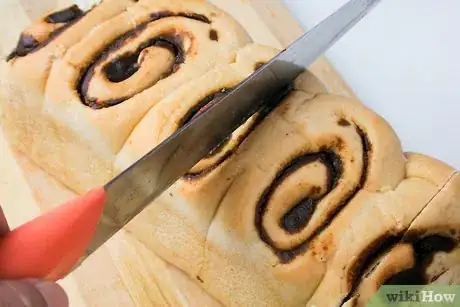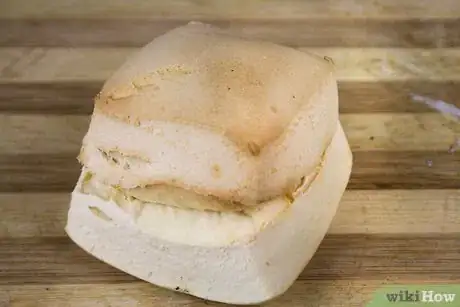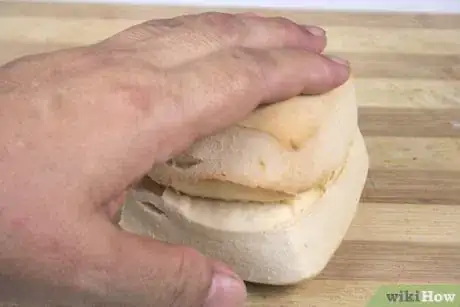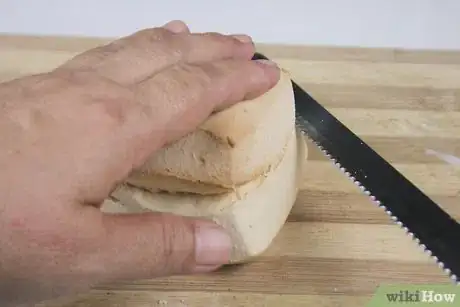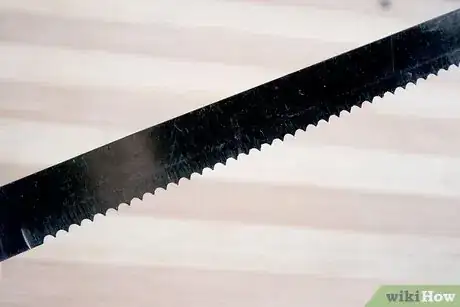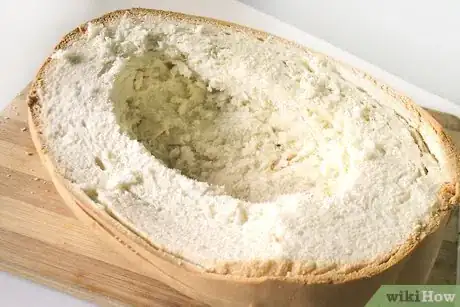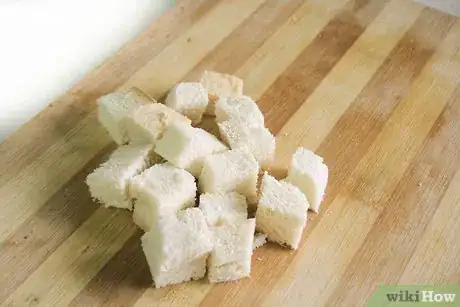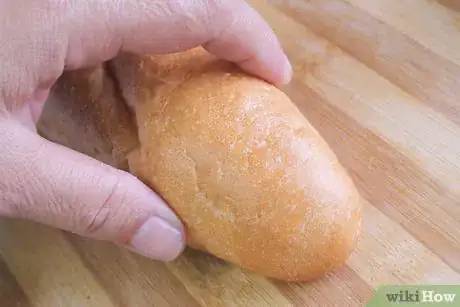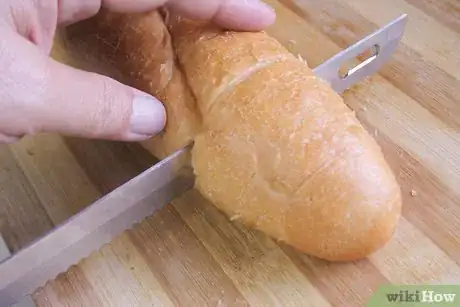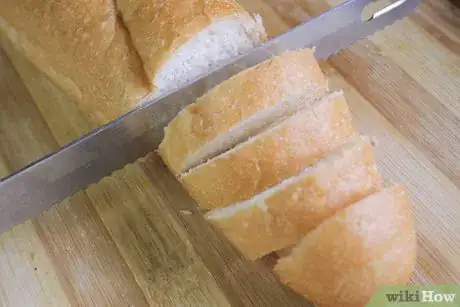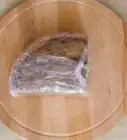wikiHow is a “wiki,” similar to Wikipedia, which means that many of our articles are co-written by multiple authors. To create this article, 11 people, some anonymous, worked to edit and improve it over time.
There are 7 references cited in this article, which can be found at the bottom of the page.
This article has been viewed 98,083 times.
Learn more...
Slicing bread may seem like an easy task, but there a few tricks to get it just right. This article will show you different ways of slicing bread. It will also show you how to cut bread bowls, as well as giving you tips for cutting freshly-baked bread and using electric bread knives.
Steps
Slicing a Loaf of Bread
-
1Choose a suitable bread knife. The best bread knives will have a deep, serrated edge. The blade should extend all the way into the handle. If the blade only extends partway into the handle, then your knife won't have enough support.[1]
- Some people find that bread knives with a wavy edge are easier to cut with than bread knives with a jagged edge.
-
2Place your loaf of bread on a large, wooden cutting board. The board should be a little longer than the loaf of bread itself. This way, you will have enough room for the slices as you cut them. Position the loaf towards one end of the board. You'll start cutting from the side that has the most board space available.Advertisement
-
3Consider slicing large, round loaves in half. If you have a really large loaf of bread, you might find it easier to work with if slice it right down the middle. This way, you'll end up with two semi-circles. When you go to slice these halves, place the halves cut-side-down on the board.[2]
-
4Place your hand over the crust and gently grip the loaf by the sides. This will keep it from slipping around on the cutting board. Avoid pressing down on top of the loaf. This will only mush the bread inside.
-
5Go into the crust at a slight angle. Position your knife close to the heel of the loaf. Angle it slightly and saw into the bread.
-
6Saw downwards once the knife pierces the crust. As soon as the knife gets into the bread, position the knife so that the blade edge is parallel to the cutting board. Use a back and forth sawing motion as you cut downward. Apply only a little bit of pressure; if you have a good knife, you won't have to press hard at all.
- You can make the slices as thin or as thick as you want them. A good guideline is ½ to 1 inch (1.27 to 2.54 centimeters) thick.
- You can also use the width of your finger as a cutting guide.[3]
Slicing Rolls, Buns, and Bagels
-
1Choose a bread knife with a serrated edge. The deeper the serrated edge is, the better; a shallow edge won't cut as well. Also, try to find a knife where the blade extends all the way through the handle. If the blade only goes partway into the handle, your knife won't have enough support.
- Your knife can have a jagged or a wavy serrated edge. Choose one that is easiest for you to cut with.
-
2Place your bread roll flat on a cutting board. Make sure that the cutting board is big enough to fit the entire bread roll. This will work for rolls, buns, bagels, English muffins, and baguettes.
-
3Place your free hand on top of the bread roll to hold it steady. If you are working with a smaller piece of bread, such as a bagel or an English muffin, then you can use your fingertips.
-
4Place your knife against the side of the roll. The serrated edge should be touching the side of the roll. The flat side of the blade should be parallel to the cutting board. Try to position the knife right in the center.
-
5Saw back and forth across the bread roll. When you reach the end, you can flip the roll on it's side and continue sawing downward.
- If you are cutting a baguette for a sandwich, consider stopping just short of the long end.. This way, you can open it up like a hot dog bun, and stuff it with sandwich goodies.
Slicing Baguettes for Hors d’oeuvres
-
1Choose a bread knife. Try to find one that has a deep, serrated edge. A knife with a shallower edge may not cut as well. Also, try to find a bread knife whose blade goes all the way through the handle. It will give you the best support. A bread knife whose blade only extends partway into the handle will not give you enough support.
- Some people find that knives with wavy edges are easier to use than knives with jagged edges.
-
2Place your baguette flat on a cutting board. If your cutting board is not long enough, then place part of the baguette on the board. As you continue to slice it, you will scoop the sliced parts off to the side and push the baguette further up onto the board.
-
3Cut the baguette into thin slices. Start by going into the baguette at a slight angle, close to the heel. Once the knife pierces the crust, position the knife so that the jagged blade is parallel to the cutting board.
- For thin slices, try cutting them ¼ to ½ inch (0.65 to 1.27 centimeters).
- For thicker slices, try cutting them 1 to 2 inches (2.54 to 5.08 centimeters) tick.
-
4Consider cutting thicker slices in half. Place a slice cut-side-down onto the cutting board. Cut the slice straight down the middle so that you end up with two half-circles. Repeat this for the rest of the thick slices.
- If the bread is very sturdy, you can set it down on the cutting board and cut horizontally into it, with the flat side of the blade parallel to the cutting board.
- You can also use this technique for ciabatta bread.
-
5Serve your bread slices. Top the thin slices with ham, salami, or thin slices of cheese. Serve the thicker, half-circle slices with dips or olive oil.
- If you are serving your bread with olive oil, consider mixing in some balsamic vinegar and dried herbs, such as oregano, rosemary, thyme, or basil.
Cutting Sourdough for Bread Bowls
-
1Get a round, 6 inch (15.24) wide bread roll. Most bread bowls are made using sourdough, but French bread could also be tasty.
-
2Slice the top third off with a serrated bread knife and set it aside. Turn the bread roll on its side, and use your bread knife to slice the top part off. Set the top part you just cut off to the side. This will become the lid for your bread bowl later on.[4]
-
3Cut a circle inside the bread bowl, about ¼ to ½ inch (0.64 to 1.27 centimeters) away from the edge. Be careful not to cut all the way through the bottom of the bread.[5]
- You can use a bread knife or a paring knife for this.
-
4Pull the circle out. It should peel away from the bottom. If you want, you can hallow out the sides using a spoon or your fingers. Be careful not to make the inner walls too thin, however.[6]
-
5Consider cutting the bread circle you pulled out into cubes. You can use these cubes for dipping into the soup or sauce.
-
6Pour the soup or dip into the bread bowl. If you want, you can place the lid on top to keep the soup or dip warm. Serve the bread bowl with the bread cubes for dipping.
Using an Electric Knife
-
1Use an electric knife to get thin slices or to cut warm bread. Keep in mind, however ,if you are cutting warm bread, you'll need to go for thicker slices. This will help keep the bread from going all mushy.
-
2Hold the bread lightly by the sides. Hold it just firmly enough to keep it in place, but not so firmly that you are squashing it.
-
3Turn the knife on and cut into the bread slightly from the side. Keep the knife at a slight angle.
-
4Cut straight down once you pierce the crust. Position the knife so that it is parallel to the cutting board. Carefully bring it down towards the board.
-
5Cut the slices as thin or as thick as you want them. If the bread is warm, you might have more luck with thicker slices.[7]
Community Q&A
Did you know you can get answers researched by wikiHow Staff?
Unlock staff-researched answers by supporting wikiHow
-
QuestionHow do I slice crusty bread?
 wikiHow Staff EditorThis answer was written by one of our trained team of researchers who validated it for accuracy and comprehensiveness.
wikiHow Staff EditorThis answer was written by one of our trained team of researchers who validated it for accuracy and comprehensiveness.
Staff Answer wikiHow Staff EditorStaff AnswerPlace the loaf of crusty bread on its side. By cutting the bread from its side rather than from top down, you are able to gain access to the softer part of the bread, making it easier to cut through the harder top and bottom crusts. From this position, use a serrated bread knife to cut through the top and bottom at the same time, pressing down on the side, top and bottom while moving the knife back and forth. Repeat for as many slices as you need.
wikiHow Staff EditorStaff AnswerPlace the loaf of crusty bread on its side. By cutting the bread from its side rather than from top down, you are able to gain access to the softer part of the bread, making it easier to cut through the harder top and bottom crusts. From this position, use a serrated bread knife to cut through the top and bottom at the same time, pressing down on the side, top and bottom while moving the knife back and forth. Repeat for as many slices as you need. -
QuestionHow can I cut bread without squashing it?
 wikiHow Staff EditorThis answer was written by one of our trained team of researchers who validated it for accuracy and comprehensiveness.
wikiHow Staff EditorThis answer was written by one of our trained team of researchers who validated it for accuracy and comprehensiveness.
Staff Answer wikiHow Staff EditorStaff AnswerIt is important to use the right knife when cutting bread; use a serrated bread knife for this purpose. The blade will slice through the bread easily, preventing any need to dig into and squash the bread. Other things to try include: Don't lean into or press on the bread as you cut; be gentle when cutting back and forth––there is no rush needed; and try slicing the bread on its side rather than from top to bottom. All of these things can help you avoid squashing the bread. However, if it is still happening, it may be that the type of bread is very soft and prone to this happening––if so, your local baker may be happy to pre-slice it for you in an automated machine.
wikiHow Staff EditorStaff AnswerIt is important to use the right knife when cutting bread; use a serrated bread knife for this purpose. The blade will slice through the bread easily, preventing any need to dig into and squash the bread. Other things to try include: Don't lean into or press on the bread as you cut; be gentle when cutting back and forth––there is no rush needed; and try slicing the bread on its side rather than from top to bottom. All of these things can help you avoid squashing the bread. However, if it is still happening, it may be that the type of bread is very soft and prone to this happening––if so, your local baker may be happy to pre-slice it for you in an automated machine. -
QuestionHow can I cut bread into cubes?
 wikiHow Staff EditorThis answer was written by one of our trained team of researchers who validated it for accuracy and comprehensiveness.
wikiHow Staff EditorThis answer was written by one of our trained team of researchers who validated it for accuracy and comprehensiveness.
Staff Answer wikiHow Staff EditorStaff AnswerUse sliced bread for this purpose, as the slices will all be even. Cut the crusts off each slice of bread to be used. Cut even lengths across the bread, leaving you with "sticks" of bread. Then cut across the sticks at even intervals, and you'll have bread cubes. Bread cubes can be used to make croutons, stuffing, crumb bases, etc.
wikiHow Staff EditorStaff AnswerUse sliced bread for this purpose, as the slices will all be even. Cut the crusts off each slice of bread to be used. Cut even lengths across the bread, leaving you with "sticks" of bread. Then cut across the sticks at even intervals, and you'll have bread cubes. Bread cubes can be used to make croutons, stuffing, crumb bases, etc.
Warnings
- Never cut a bread roll or bun while holding it in your hand. Always place it on a cutting board before you begin slicing it.⧼thumbs_response⧽
- If you are cutting homemade bread using a good knife, and the bread is just not cutting right, the issue might lie with the bread itself. If the bread has too much gluten in it, it will be too springy. If the bread has too little gluten in it, it will be too crumbly.[13]⧼thumbs_response⧽
Things You’ll Need
- Cutting board
- Bread knife
References
- ↑ The Frugal Girl, How to Slice Homemade Bread
- ↑ Sourdough Home, How To Slice Bread
- ↑ Sourdough Home, How To Slice Bread
- ↑ The Taste Place, Easy Do It Yourself Sourdough Bread Bowls
- ↑ The Taste Place, Easy Do It Yourself Sourdough Bread Bowls
- ↑ Pamela's Products, Crispy French Bread Bowl
- ↑ Chickens in the Road, How to Cut Bread
- ↑ Sourdough Home, How To Slice Bread
- ↑ Chickens in the Road, How to Cut Bread
- ↑ Reluctant Gourmet, Bagel Cutter – How to Slice a Bagel
- ↑ The Kitchn, The Best Ways to Store & Reheat Bread
- ↑ The Kitchn, The Best Ways to Store & Reheat Bread
- ↑ The Frugal Girl, How to Slice Homemade Bread
About This Article
To slice a loaf of bread, place it on a cutting board and grip one side with your non-dominant hand. Next, select a knife with a deep, serrated edge and decide where you want to start cutting. Then, saw into the bread, cutting at a slight angle, until you pierce the crust. Finally, reposition the knife so the blade is perpendicular to the cutting board and continue using back-and-forth sawing motions as you cut downward. For tips on cutting rolls, buns, and bagels, read on!


